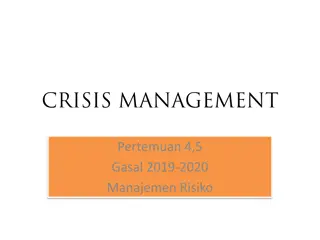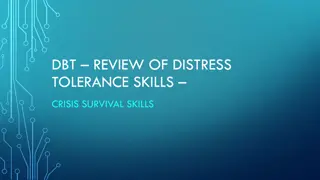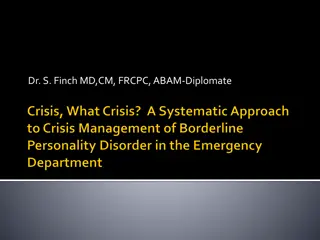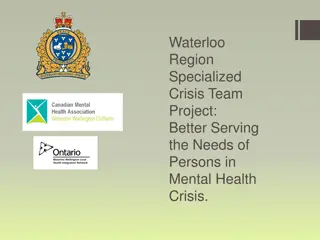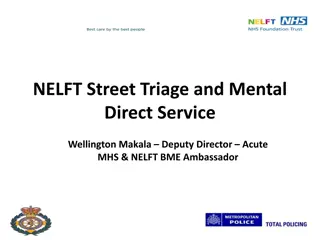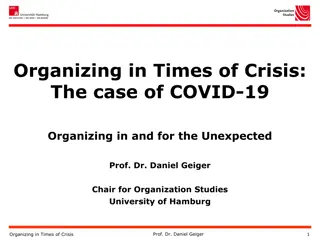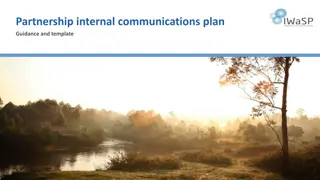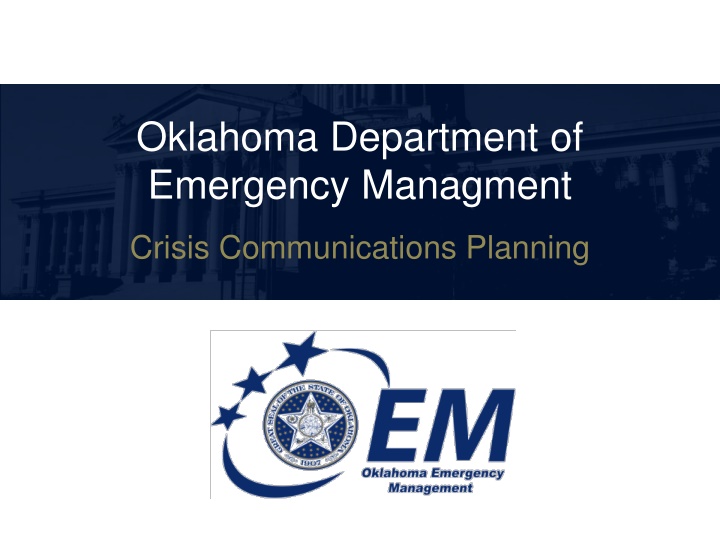
Crisis Communications Planning for Emergency Management in Oklahoma
Learn about crisis communications planning for the Oklahoma Department of Emergency Management, including the importance of having a plan, how to develop it, objectives to accomplish, team roles, audience identification, hazard assessment, and template creation. Be prepared for emergencies with effective communication strategies.
Download Presentation

Please find below an Image/Link to download the presentation.
The content on the website is provided AS IS for your information and personal use only. It may not be sold, licensed, or shared on other websites without obtaining consent from the author. If you encounter any issues during the download, it is possible that the publisher has removed the file from their server.
You are allowed to download the files provided on this website for personal or commercial use, subject to the condition that they are used lawfully. All files are the property of their respective owners.
The content on the website is provided AS IS for your information and personal use only. It may not be sold, licensed, or shared on other websites without obtaining consent from the author.
E N D
Presentation Transcript
Oklahoma Department of Emergency Managment Crisis Communications Planning
Crisis Communications Plans Why have a plan? Outlines roles, responsibilities, and protocols to guide information sharing during an emergency or crisis You don t want to be making these decisions WHEN a crisis occurs
How to develop a plan? Bring your communications team together Brainstorm and walk through various scenarios Look at samples online Most important: Don t rush through it the planning process is just as important as the end result!
What do you want to accomplish? Purpose To successfully withstand a crisis Scope Internal and external audiences Objectives Provide factual information as quickly as possible Outcomes A guide for what to do during a crisis
Who is on your team? Public Information Officer Public Affairs Public Relations Marketing Other communications staff Leadership
Identify audiences Identify each audience you may need to reach during a crisis or emergency Leadership Legislative/Congressional Boards or commissions Staff Media External stakeholders General public
Identify potential hazards Identify all potential hazards that may impact your agency Categorize based on how likely each hazard is to occur and how damaging each would be Example: 1. Tornado 2. Ice storm 3. Flash flooding 4. Etc.
Develop templates Create a variety of pre-approved templates that can be quickly accessed in a crisis by all members of the team. News releases Statements Fact Sheets Blog entries Social media posts
Templates - example At approximately (time), we learned that (give brief statement). We cannot give any more information at this time about the extent of the damage or possible injuries other than to say it has involved (specific facility, location, etc.). As soon as we have additional information, we will let the public know.
Identify roles needed Spokesperson Writer Messaging Fact gatherer Liaisons (leadership, VIPs, staff, etc.) Social media, website updates Phone bank Media and social media monitoring Media relations/escorts Secretary
Staffing levels Identify what staffing you will need for various levels of crisis or emergency Example: Small wildfire two PIOs May 20 tornadoes all hands
Contact lists A crisis is not the time to have to search for contacts or phone numbers. Maintain updated contact lists for: Media Other agencies that may be involved VIPs / Legislative / Congressional, etc.
Approval process Identify the approval process for each type of message Social media News releases Fact sheets Statements, etc. Determine if approval process will change during crisis Identify a trusted backup
Locations Where will your team meet during a crisis or emergency? Determine location and backup location Consider logistics: communications needs, supplies, tools, etc.
Logistics and supplies Wi-Fi and/or network connection Laptops Phones Printers and Copiers Paper, pens, post-its, paperclips, staplers, etc. Bathrooms nearby Heating, Air Conditioning
Education and training How will you provide training to your team prior to a crisis or emergency? Social media training Media training Web updates Writing
Immediate response Initial tasks Activate alert system (email/text/etc.) Internal memo to management/staff Initiate phone tree Media alert Social media updates Update agency website Update emergency phone line Gather crisis communications team for further needs Identify roles based on level of crisis Secretary, monitor, fact gatherer, writers, spokesperson, phone bank, etc.
Secondary and ongoing response Develop key messages for each audience to address incident Develop statement from leadership Determine if/when/where a news conference should be held Gather and disseminate info to each audience as needed Don t forget internal audiences
Schedule a news conference If needed, schedule a briefing or news conference as soon as you are able Pre-identify locations for briefings Use pre-identified spokespeople Provide a written statement or fact sheet to media Consider using sign-language interpreter
After a disaster Evaluate media coverage and identify successes and opportunities Assess how the plan functioned Hold an after action meeting with the team Identify how to help the community recover
Michelann Ooten, Deputy Director michelann.ooten@oem.ok.gov Keli Cain, Public Information Officer keli.cain@oem.ok.gov


